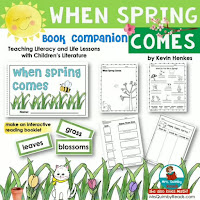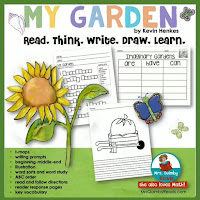Children's literature for grades K-3 offers many benefits, fostering early literacy skills and a love for reading. Stories introduce young readers to rich vocabulary, diverse perspectives, and language structure, enhancing comprehension and fluency. Beyond academic development, these books also support social-emotional growth by exploring friendship, empathy, and resilience themes. Children’s literature sparks imagination, encourages creativity, and builds a foundation for lifelong learning by making education enjoyable and accessible.
Find book companions for the many books you read in the classroom at MrsQuimbyReads.
With these book companions, your students will stay engaged while reading quality children's literature. Read aloud or read independently. Then, follow the natural rhythms of talking, listening, and writing. Building a community of readers and writers in your classroom will improve academic success in all subjects.
 |
| When Spring Comes |
 |
| Zinnia's Flower Garden |
Why Teachers Use Children’s Literature to Teach Reading
Walking into any elementary classroom, you’ll likely see a bookshelf full of well-loved children’s books. From timeless classics to new favorites, children’s literature is at the heart of how many teachers approach reading instruction—and for good reason.
These books are more than just stories; they are powerful tools for helping children learn to read and love reading.
Here are some of the key reasons why teachers use children’s literature when teaching reading:
1. It Captures Students’ Attention
Children’s literature is designed with young readers in mind. The illustrations are vibrant, the stories are engaging, and the characters are often relatable or humorous. When students are genuinely interested in a story, they are more motivated to read, listen, and discuss. That engagement is the first step toward building strong reading skills.
2. It Builds Language and Vocabulary
Children’s books expose students to rich and varied language. Whether it’s the playful rhyme of a Dr. Seuss book or the lyrical prose of a picture book, these texts help young readers hear and absorb language structures, new vocabulary, and the rhythm of written language. This exposure is essential for language development.
3. It Teaches Reading Strategies in Context
Teachers use children’s books to model strategies like predicting, questioning, summarizing, and inferring. Because the stories are meaningful and accessible, students can practice these skills naturally and enjoyably. Learning to read isn’t just about sounding out words—it’s about making sense of what you read. Literature supports this kind of deep, thoughtful reading.
4. It Builds Background Knowledge
Books open windows to the world. They introduce students to different cultures, environments, historical events, and everyday experiences beyond their own. This background knowledge is crucial for comprehension—it gives students the context they need to understand more complex texts as they grow.
5. It Supports Social and Emotional Learning
Many children’s books deal with themes that help children navigate their feelings and relationships, like friendship, empathy, courage, and perseverance. Discussing these themes in the context of a story helps students understand themselves and others better. Literature becomes a safe space to explore big ideas and emotions.
6. It Encourages Cross-Curricular Learning
Children’s literature can connect reading with science, math, social studies, and art. Teachers often design thematic units around a book or a topic, using stories as a launchpad for deeper learning across the curriculum.
7. It Promotes Representation and Belonging
Diverse books allow students to see themselves reflected in stories and also introduce them to lives and perspectives different from their own. This helps build empathy and a classroom culture of inclusion and respect.
8. It Fosters a Lifelong Love of Reading
Ultimately, the goal of reading instruction isn’t just for kids to become better readers—it’s to help them become readers who love books. Children’s literature creates positive, memorable reading experiences that stick with students long after they’ve finished a book.
Final Thoughts
Using children’s literature in the classroom isn’t just a teaching strategy—it’s a way to connect with students, build community, and cultivate a love of reading that can last a lifetime. Whether you're a teacher, a parent, or a librarian, keep sharing great books with kids. The impact is more profound than you might think.
| I Am Peace |






